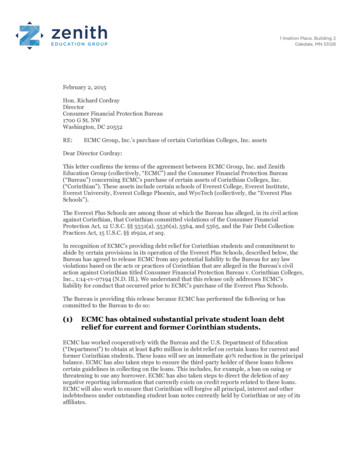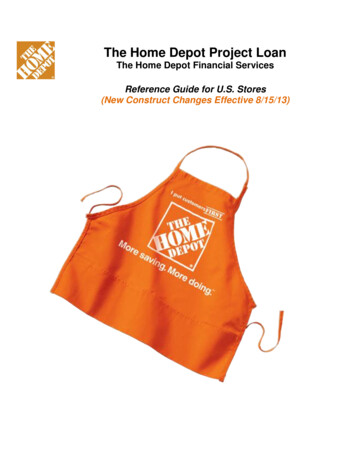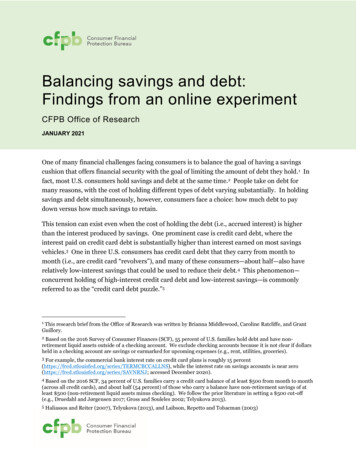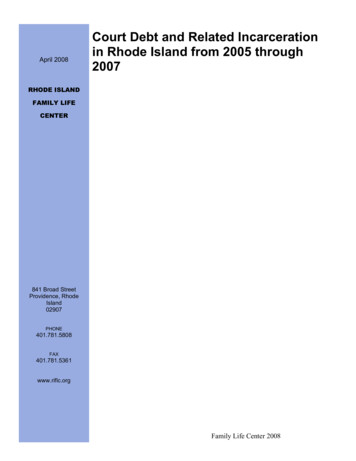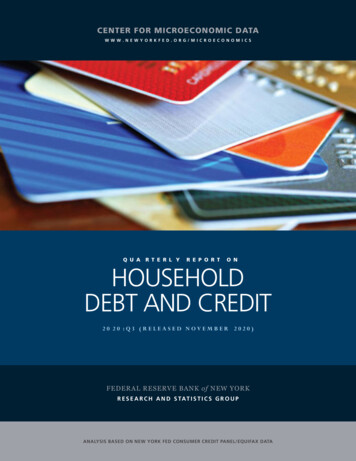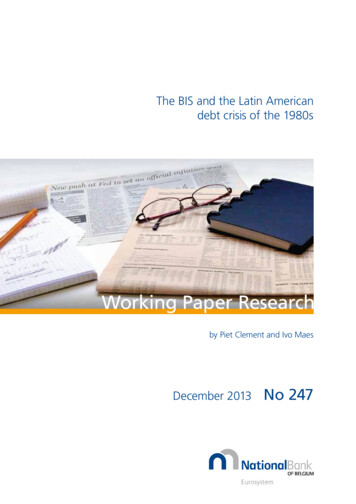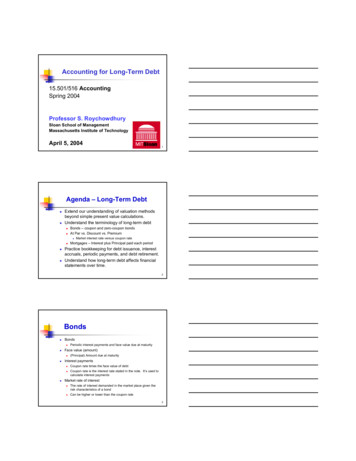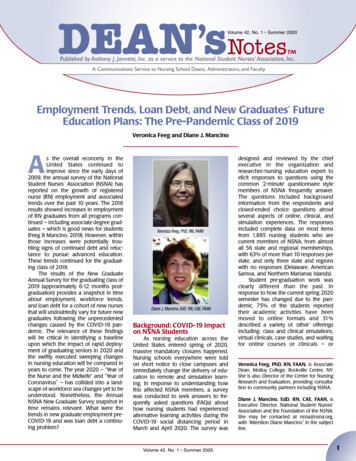
Transcription
Volume 42, No. 1 Summer 2020Employment Trends, Loan Debt, and New Graduates’ FutureEducation Plans: The Pre-Pandemic Class of 2019Veronica Feeg and Diane J. MancinoAs the overall economy in theUnited States continued toimprove since the early days of2009, the annual survey of the NationalStudent Nurses’ Association (NSNA) hasreported on the growth of registerednurse (RN) employment and associatedtrends over the past 10 years. The 2018results showed increases in employmentof RN graduates from all programs continued – including associate degree graduates – which is good news for students(Feeg & Mancino, 2019). However, withinthose increases were potentially troubling signs of continued debt and reluctance to pursue advanced education.These trends continued for the graduating class of 2019.The results of the New GraduateAnnual Survey for the graduating class of2019 (approximately 6-12 months postgraduation) provides a snapshot in timeabout employment, workforce trends,and loan debt for a cohort of new nursesthat will undoubtedly vary for future newgraduates following the unprecedentedchanges caused by the COVID-19 pandemic. The relevance of these findingswill be critical in identifying a baselineupon which the impact of rapid deployment of graduating seniors in 2020 andthe swiftly executed sweeping changesin nursing education will be compared inyears to come. The year 2020 – “Year ofthe Nurse and the Midwife” and “Year ofCoronavirus” – has collided into a landscape of workforce sea changes yet to beunderstood. Nonetheless, the AnnualNSNA New Graduate Survey snapshot intime remains relevant. What were thetrends in new graduate employment preCOVID-19 and was loan debt a continuing problem?Veronica Feeg, PhD, RN, FAANDiane J. Mancino, EdD, RN, CAE, FAANBackground: COVID-19 Impacton NSNA StudentsAs nursing education across theUnited States entered spring of 2020,massive mandatory closures happened.Nursing schools everywhere were toldon short notice to close campuses andimmediately change the delivery of education to remote and simulation learning. In response to understanding howthis affected NSNA members, a surveywas conducted to seek answers to frequently asked questions (FAQs) abouthow nursing students had experiencedalternative learning activities during theCOVID-19 social distancing period inMarch and April 2020. The survey wasVolume 42, No. 1 Summer 2020designed and reviewed by the chiefexecutive in the organization andresearcher/nursing education expert toelicit responses to questions using thecommon ‘2-minute’ questionnaire stylemembers of NSNA frequently answer.The questions included backgroundinformation from the respondents andclosed-ended choice questions aboutseveral aspects of online, clinical, andsimulation experiences. The responsesincluded complete data on most itemsfrom 1,885 nursing students who arecurrent members of NSNA, from almostall 56 state and regional memberships,with 63% of more than 10 responses perstate, and only three state and regionswith no responses (Delaware, AmericanSamoa, and Northern Marianas Islands).Student pre-graduation work wasclearly different than the past. Inresponse to how the current spring 2020semester has changed due to the pandemic, 75% of the students reportedtheir academic activities have beenmoved to online formats and 31%described a variety of ‘other’ offeringsincluding: class and clinical simulations,virtual clinicals, case studies, and waitingfor online courses or clinicals – orVeronica Feeg, PhD, RN, FAAN, is AssociateDean, Molloy College, Rockville Centre, NY.She is also Director of the Center for NursingResearch and Evaluation, providing consultation to community partners including NSNA.Diane J. Mancino, EdD, RN, CAE, FAAN, isExecutive Director, National Student Nurses’Association and the Foundation of the NSNA.She may be contacted at nsna@nsna.org,with “Attention Diane Mancino” in the subjectline.1
Figure 1A.Clinical Options Pre-COVID-19Clinical Options used by your school during the spring 2020 semester prior to theCOVID-19 pandemic include (check all that apply):100%Responses80%60%40%20%0%Direct ne/virtual)Written case studiesor clinical groupstudiesFigure 1B.Clinical Options Post-COVID-19Clinical options now used by your school following the outbreak of theCOVID-19 pandemic include (check all that online/virtual)Written casestudies orclinical groupcase studiesClinical canceledthis semesterdue to pandemic(simulation, casestudies, directpatient contact)0.95%73.90%61.27%24.19%Volume 42, No. 1 Summer 2020Clinical time inclinical settingas paidVolunteer time in employee (i.e.clinicalstudent nursesetting istechnician;counted towards certified nursingclinical hours byassistant)my schoolis countedtoward clinicalhours by myschool2.81%1.33%Other(pleasespecify)7.90%
Figure 2.Employment Rates by Regions of the Country for the Past 10 rtheastCentralFigure 3.Employment by Types of Educational Programs 2017-201992%90%88%86%84%82%80%201720182019Q7: Associate degree (ADN)87%87%84%Q7: Baccalaureate degree (BSN pre-licensure)91%91%90%Q7: Accelerated BSN program (pre-licensure)85%88%84%Q7: Associate degree (ADN)Q7: Baccalaureate degree (BSN pre-licensure)Volume 42, No. 1 Summer 2020Q7: Accelerated BSN program (pre-licensure)3
Figure 4A.Overall Employment Rates by Types of Schools (Public, Private, ic89%89%87%Private (not-for-profit)88%89%88%Private (for-profit)84%88%83%PublicPrivate (not-for-profit)Private (for-profit)Figure 4B.Regional Employment Rates by Types of Schools (Public, Private, stCentralPublic92%76%87%95%Private (not-for-profit)92%83%83%96%Private (for-profit)86%81%76%92%Public4Private (not-for-profit)Private (for-profit)Volume 42, No. 1 Summer 2020
Figure 5.Comparisons 2014 and 2019 Responses of Continuing BSN/MS EducationQuestion: If you graduated with an associate degree or from a diploma school of nursing and you are planning to purse anRN to BSN or RN to MSN, when will you enroll?40%35%30%25%20%15%10%5%0%CurrentlyEnrolled (Fall)SpringNext FallIn 2 YearsIn 3 Years2014In 4 YearsAfter 5 Years No Plans toContinueUnsure2019Figure 6.Loan Debt by Type of Nursing Program 100,000 90,000 80,000 70,000 60,000 50,000 40,000 30,000 20,000 10,000 Associate Degree(ADN)BaccalaureateDegree(BSN pre-licensuretraditional program)Accelerated BSNProgram(pre-licensure)Master’s DirectEntry Degree(pre-licensuredirect entrymasters)Volume 42, No. 1 Summer 2020Clinical NurseLeader MastersDirect Entry(pre-licensuredirect entrymasters)RN to BSN(post-licensure)5
Figure 7.Loan Debt by Types of Schools (Public, Private, Proprietary) 50,000 45,000 40,000Average Debt 28,967 35,000 30,000 25,000 20,000 15,000 10,000 5,000 Public(Examples: state collegesand state universities;community colleges)delayed indefinitely. In response to howclinical experiences were being implemented for spring 2020 prior to (and following) the COVID-19 pandemic, students selected a combination of optionspre- and post- that were clearly different(see Figure 1A and Figure 1B). Less than10% reported simulation/patient care as50%/50%. In some cases (other typed indescriptions) students responded that100% was simulation or virtual, withvery few responding that 90-100% waspatient care only.New Nurses: GraduatesFrom 2019Consecutive data collection of newRN graduates from the NSNA surveyreported over the past years providesinsight into RN workforce and trends innursing education, loan debt, and plansfor additional education by nursing students. Clearly, these past trends may beimpacted on the post-COVID-19 ‘Class of2020’ but, prior to this, employmentdemonstrated (over the past 10 years) acontinuous upward movement or stableevidence of new graduates finding jobsand employment opportunities in all6PrivateNot-For-Profit(Examples: New YorkUniversity, VillanovaUniversity, DrexelUniversity, etc.)ProprietaryFor-Profit(Examples: ChamberlainCollege; University ofPhoenix; Fortis;Rasmussen; Keiser; etc.)areas of the country until this year; downoverall from 2018 (89%) to (87%) in2019, with a slightly downward trend allbut the central region of the country (seeFigure 2). If the trend indicates an emerging trend about employment, the class of2020 – who were catapulted into practice quickly – and those students behindthem who are experiencing more simulation-based education, may have a different employment experience than wehave seen before 2019.Breaking this down by types of programs, it appears that associate degreenurse (ADN) graduates were finding itmore difficult to find employment (seeFigure 3) (p 0.05) in 2019 compared toprevious years, and baccalaureatedegree nurses (BSN) employment rateswere higher than other types of programs.To further explore how employmentchanged by types of schools (public, private [not-for-profit], and proprietary [forprofit]), findings suggest with the overalldecrease in employment rates in 2019,especially regionally other than the central region, employment in all types ofschools decreased from 2019 with theVolume 42, No. 1 Summer 2020Overall Debtwidest drop in proprietary schools (seeFigure 4A). This was also remarkable andvaried by regions for 2019 (see Figure 4B)with low rates (76%) for public schools inthe West. These differences suggest theremay be differences in numbers of different types of schools responding byregions and the job market saturationimpacts the West public schools evenmore than the other types of schools.The Impact of Loan Debt onFuture Education PlansWith the ongoing policy discussionsabout the burden of loan debt, it wasimportant this year to examine thedetails about program choice and hownursing student loan debt may impactprogression or continuation in nursingeducation. Does program type impactamount of loan debt and does loan debtinfluence students’ plans to further theirnursing education? These are importantquestions to raise with the nationalfocus on student loan debt burden.One focus was on whether or notADN nurses planned to pursue highereducation in general, and what plansall new graduates have in advanced
education. For a 5-year comparison,the question for analysis was:If you have an Associates orDiploma Degree, when are youplanning to enroll in advanceddegree?Over the past years (2014-2018),the trend demonstrated diminishingplans to continue for a degree in thenear future and more responses projected it as a future plan, with increasing unknown (see Figure 5).Comparing 2019 and 2014, thereis a clear downward trend in new graduates with ADN to pursue their BSN orMSN. For example, those ‘currentlyenrolled’ in 2019 (31%) were lowerthan those ‘currently enrolled’ in 2014(34%); for those who are unsure orhave no plans to continue, theincrease is more than 7%. Analysis ofthe mean loan debt for these newgraduates planning within 2 years (m 26,249) versus those without plans(m 29,704) was significantly different (t 3.55, p 0.001).Comparing student loan debt data,programs were significantly differentfor program type as well as types ofschool. The overall loan debt for theClass of 2019 was 28,967 with arange of debt across different types ofprograms (see Figure 6). Although theaverage debt for Masters Direct Entryand Clinical Nurse Leaders Mastersappear significantly higher, the meanscores are based on small samples relative to the ADN and BSN responsesand should be interpreted with caution. Comparing ADN and BSN newgraduates, there was a significant difference in average loan debt for ADN( 18,968) and BSN ( 27,948) (t 9.98,p 0.001). Comparing types ofschools, there was a significant difference in average loan debt for public( 19,007), private ( 41,087), and proprietary schools ( 46,664) (p 0.001) (seeFigure 7).DiscussionWith the introduction of COVID-19into the world of health care and nursing, many new variables enter theexamination of new RN graduate experiences. The data that will be collectedbeginning September 2020 will reflect anew graduate environment like noneother than we have known in modernnursing. While it is early in the newworld review of impacts on new graduate RNs, we anticipate a period of disruption followed by a leveling off oncethe population is vaccinated.We will look to see what theimpacts are from the alternations madein clinical requirements and settings forthe nursing class of 2020. With the suspension of clinical experiences for nursing students by many hospitals,students were unable to meet thelicensing exam requirements for clinicalexperience. The creation of a practiceacademic partnership model, endorsedby the National Council of State Boardsof Nursing (NCSBN) and several nursingorganizations including NSNA, supports academic recognition for supervised clinical experience for senior students practicing in healthcare settings.The academic institution accepts workhours for the fulfillment of clinicalhours. Success of this model has beenreported in Idaho and Iowa for bothADN and BSN (NCSBN, 2020). As thismodel is embraced and more practiceacademic partnerships are established,this innovative solution, born out of acrisis, may have a positive lastingimpact on fulfilling clinical requirements and providing employment fornursing students.In New York State, pre-licensurehealthcare students may volunteer inhealthcare facilities for educationalcredit without an affiliation agreement.The success of this model has not yetbeen reported.The 2020 survey will investigatevarious scenarios reported by studentssuch as not being able to graduate ontime, job loss impact on completingschool, and availability of entry-levelpositions. With an expectation thatthere may be a second wave of thevirus before a vaccine is availableplaces new graduates at high risk forunemployment. The virus is now surging in many states and hospitals arebecoming overwhelmed with COVID19 patients. Hiring and onboardingnew graduates during a crisis may notbe feasible especially when experienced nurses are preferred.Will we once again have an oversupply of new graduates (as we didduring the Great Recession) who willnot be hired because of lack of experience and insufficient hospital resources? Reports are emerging ofnurse layoffs, furloughs, and hiring andwage freezes (Gooch, 2020). Hospitalsare accumulating large debt resultingfrom the pandemic. Without relieffrom the federal government, hospitalsare in danger of default and insolvency. Losses from the suspension of non-Volume 42, No. 1 Summer 2020emergency procedures will be difficultto recoup as the virus continues tosurge in many places. Indeed, the ripple effect will impact all segments ofhealthcare delivery and populationhealth in general.As for student loans, it will behoove Congress to grant student loanrelief once again. Unemployment andunderemployment will make studentloan repayment difficult for many newgraduates. Additionally, students whocould not graduate on time will mostlikely require more loans and thusincrease their loan burden. Will theyhave time and resources to advancetheir education to the next degree?This too will be examined as we querythe class of 2020.As we watch these trends unfold,college administrators need to keepthe student perspective foremost indecision making. As the fall semesterapproaches, academic institutions arefaced with many difficult decisions.The safety of students and faculty mustguide decision making – not politics.Nursing education leaders and facultyare urged to advocate for their students as we all face a very challengingfuture. DNThe convenience sample of nursing students who are members of theNSNA and indicated that Spring 2019was their graduation date were sentthe survey via SurveyMonkey yielding responses from n 4,740 (23%surveys opened/10% all surveys sentto multiple emails from databasemembers) that were cleaned to includeemployment responses filtered by“graduation Winter/Spring/Summer2018 and Spring/Summer 2019” (n 4,536). Using an estimated date of survey returned between October andDecember 2019, the data representapproximately 4 months to 1-year postgraduation. Percentages are roundedto the nearest percent.ReferencesFeeg, V., & Mancino, D.J. (2019). Loan debt for newgraduates in nursing: How employment post graduation and student loan debt are affected overtime. DEAN’s Notes, 41(1), 1-5.Gooch, K. (2020). Record number of healthcare workerslaid off, furloughed during pandemic. ed-during-pandemic.htmlNational Council of State Boards of Nursing (NCSBN).(2020). Practice-academic partnerships FAQs.https://www.ncsbn.org/14573.htm7
Volume 42, No. 1 Summer 2020Anthony J. Jannetti, Inc.East Holly Avenue, Box 56Pitman, NJ 08071-0056CHANGE SERVICEREQUESTEDEditorDiane J. Mancino, EdD, RN, CAE, FAANPresident, NSNABrandi BordenExecutive DirectorDiane J. Mancino, EdD, RN, CAE, FAANArt DirectorJack BryantManaging EditorKaytlyn Mroz, MALayout and Design SpecialistDarin PetersPublisherAnthony J. Jannetti, Inc.Advisory BoardG. Rumay Alexander, EdD, RN, FAANMichael L. Evans, PhD, RN, NEA-BC, FAANFlorence L. Huey, MS, FNPMary P. Tarbox, EdD, RNRebecca M. Wheeler, PhD, RNDean’s Notes is indexed in Cumulative Index toNursing & Allied Health Literature.PRSRT STDUS PostagePAIDDeptford, NJPermit #142Dean’s Notes is published four times a year (winter, spring, summer, andfall) by Anthony J. Jannetti Inc., East Holly Avenue, Box 56, Pitman, NewJersey 08071-0056. Telephone 856.256.2300. FAX 856.589.7463. Allrights reserved. No part of this publication may be reproduced without theexpress written permission of the publisher. Address changes shouldinclude mailing label and be forwarded to the NSNAinc Anthony J. Jannetti, Inc., 2020We are excited to be offering the 38th NSNA MidYear Conference on a virtual platform this upcoming fall which will allow usto gather together across the nation. The event will be held from October 29-31, 2020. Our theme for the conference is: TheChallenge of Change. MidYear Conference provides faculty workshops earning affordable continuing education units and offers students exposure to nursing specialty areas and career and leadership development workshops. The conference includes an affordable NCLEX-RN review. Additionally, we have many exciting educational sessions, panels, and an exhibit hall filled with networkingopportunities.You can find more information about the MidYear Conference by visitingwww.nsnamidyear.orgStay tuned as we continue to provide informative andstimulating educational programs this Fall!8Volume 42, No. 1 Summer 2020
Comparisons 2014 and 2019 Responses of Continuing BSN/MS Education Question: If you graduated with an associate degree or from a diploma school of nursing and you are planning to purse an RN to BSN or RN to MSN, when will you enroll? 40% 35% 30% 25% 20% 15% 10% 5% 0% 2014 2019 Figure
